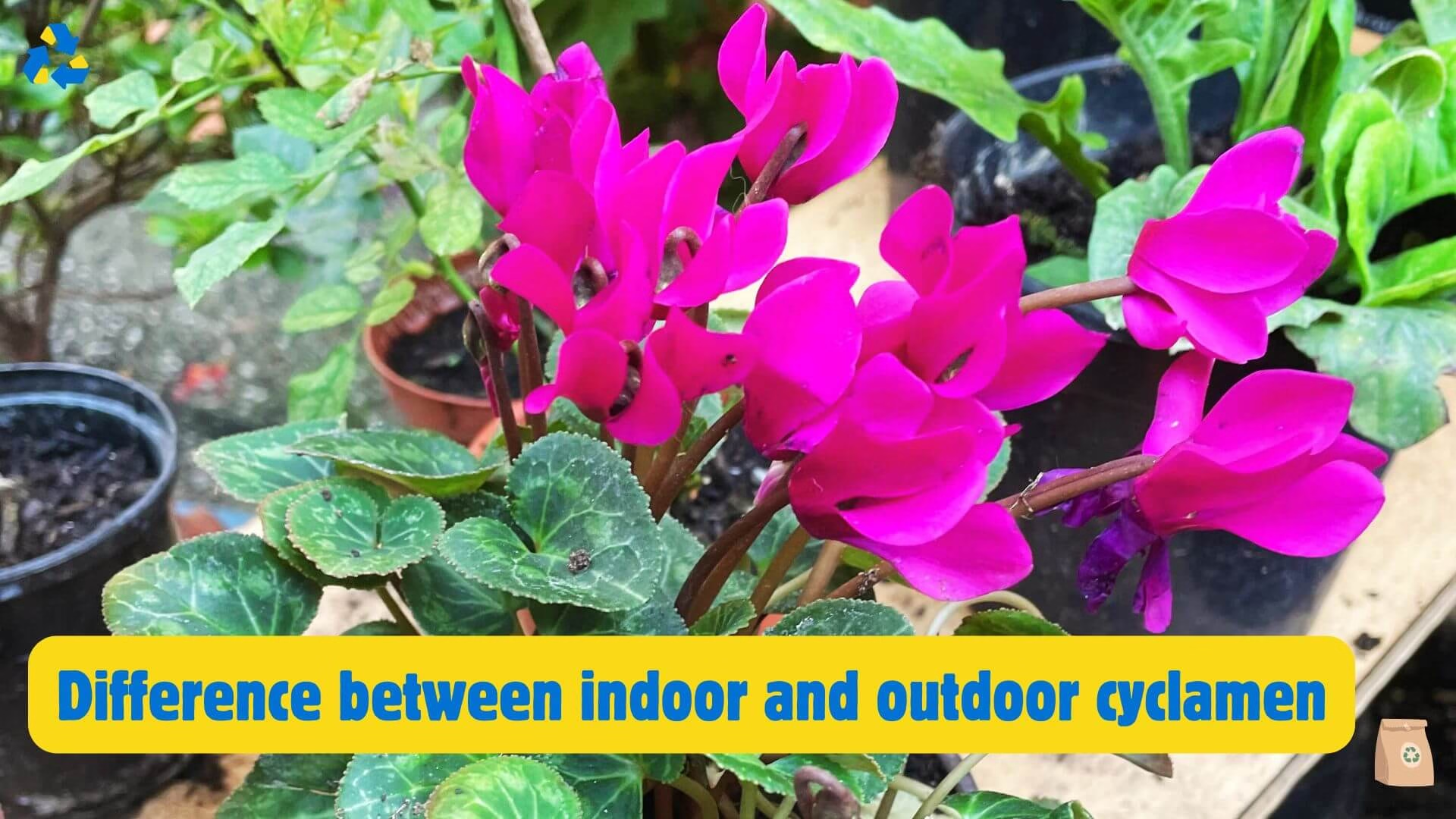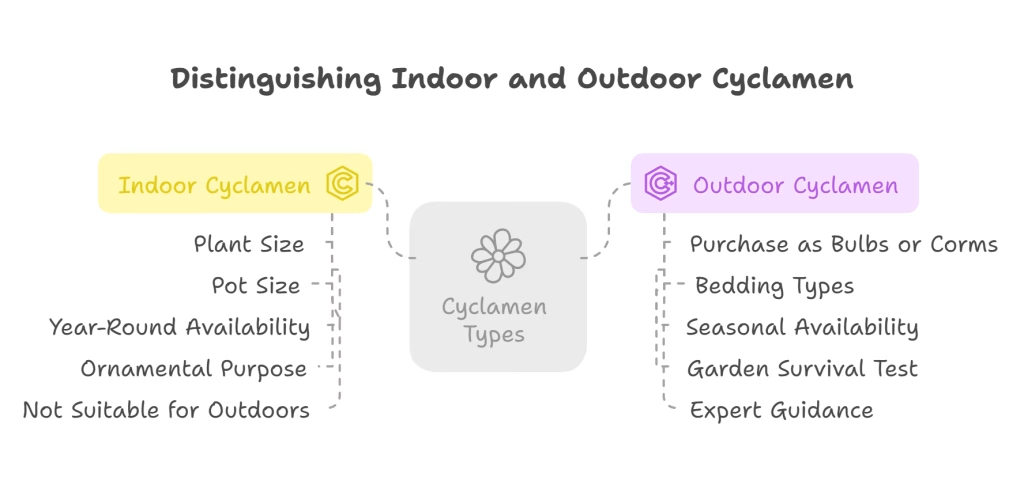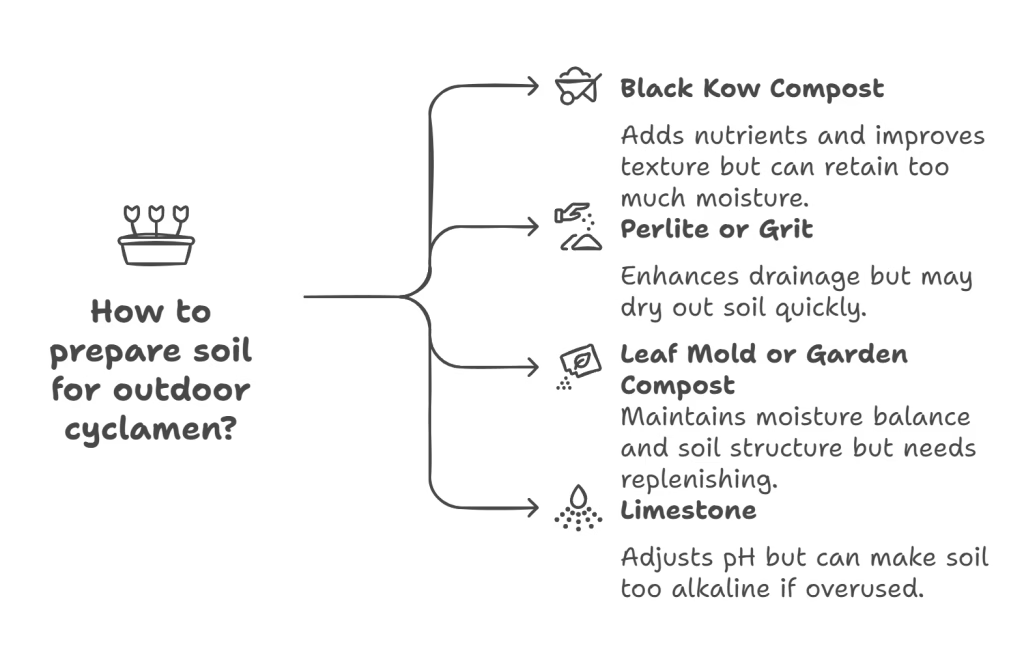
Know the Difference Between Indoor and Outdoor Cyclamen
This afternoon, something got me wondering, what’s the difference between indoor and outdoor cyclamen? To satisfy my curiosity, I did some research and found that indoor cyclamen, like Cyclamen persicum, are larger with bigger leaves and are suited for houseplant cultivation.
Wherein, outdoor cyclamen are often smaller, cold-hardy varieties like Cyclamen hederifolium and Cyclamen coum, which thrive in shaded garden settings. I will tell you more about them in this article.
How do I know if my cyclamen is indoor or outdoor?
You have to know the difference between indoor and outdoor cyclamen. To determine whether your cyclamen is an indoor or outdoor variety, you can follow these guidelines:
Indoor Cyclamen
- Plant Size: Indoor cyclamens tend to be larger plants with bigger leaves, taller and wider overall, larger flowers, and longer stems.
- Pot Size: They are often sold in larger pots compared to outdoor varieties, which are typically in smaller containers.
- Year-Round Availability: Indoor cyclamens are available year-round in nurseries and garden centers.
- Potted for Ornamental Purposes: They are commonly potted and sold as ornamental houseplants.
- Not Suitable for Outdoor Planting: Attempting to plant them outdoors may result in poor survival during the winter months.
Outdoor Cyclamen
- Purchase as Bulbs or Corms: Permanent outdoor cyclamens are typically purchased as bulbs or corms rather than potted plants.
- Bedding Types: There are smaller bedding types of outdoor cyclamens that are often available during certain seasons, usually measuring around 6-8 inches tall.
- Seasonal Availability: Outdoor cyclamens are typically available during specific planting seasons.
- Garden Survival Test: A traditional test to distinguish outdoor cyclamen is to plant them in your garden. If they survive the winter and thrive, they are likely outdoor cyclamen. If they succumb to the cold, they are probably indoor cyclamen.
- Follow Expert Guidance: If you are unsure and don’t want to risk the well-being of your cyclamen, consider seeking guidance from a knowledgeable source like a local nursery or gardening expert.
Difference Between Indoor and Outdoor Cyclamen: A Side-by-Side Comparison
Exploring the distinctions between indoor and outdoor cyclamen is essential for successful plant care. Now, let’s break down the difference between indoor and outdoor cyclamen with a handy comparison table.
| Feature | Indoor Cyclamen | Outdoor Cyclamen |
| Plant Size | Larger plants with bigger leaves, taller, and wider overall | Varies but typically smaller in size, especially the bedding types |
| Flower Size | Larger flowers with longer stems | Smaller flowers, but varied depending on the species |
| Pot Size When Sold | Larger pots are common | Sold as bulbs or corms or in smaller containers |
| Year-Round Availability | Available year-round | Typically available during specific planting seasons |
| Intended Use | Potted as ornamental houseplants | Planted outdoors in gardens or containers |
| Survival Test | May not survive well outdoors during winter | Can thrive when planted in the garden and survive winter |
| Purchase Form | Pre-potted for immediate indoor use | Purchased as bulbs or corms for outdoor planting |
| Seasonal Variation | Less variation in availability | Availability may be seasonal, especially for bedding types |
Can I Plant My Indoor Cyclamen Outside?
It’s not recommended to transplant indoor cyclamen directly outdoors unless they are a cold-hardy variety like Cyclamen hederifolium. Most indoor cyclamen, like Cyclamen persicum, are adapted to controlled indoor environments and may struggle in outdoor conditions.
Sudden temperature fluctuations, exposure to harsh sunlight, and inadequate winter protection can harm indoor cyclamen. If you wish to enjoy your indoor cyclamen outdoors, consider placing the potted plant in a sheltered, shaded spot during favorable weather.
But be prepared to bring it back indoors when conditions become less ideal. Always research the specific care requirements for your cyclamen variety to ensure its well-being.
Properties and Requirements of Indoor Cyclamen
Indoor cyclamen, primarily Cyclamen persicum, are popular houseplants known for their striking flowers and fresh foliage. To successfully care for indoor cyclamen, it’s essential to understand their properties and requirements:
1. Light
Bright, Indirect Light: Place indoor cyclamen in a location with bright, indirect sunlight. Avoid direct sunlight, as it can scorch their delicate foliage.
2. Temperature
Cooler Temperatures: Indoor cyclamen prefer cooler temperatures, ideally between 50-65°F (10-18°C). Avoid exposing them to extreme heat or cold drafts.
3. Humidity
Moderate Humidity: Maintain moderate humidity levels around the plant by placing the pot on a tray filled with water and pebbles or using a humidifier.
4. Watering
Even Moisture: Keep the soil evenly moist, but not soggy. Water when the top inch of the soil feels dry. Always use a pot with drainage holes to prevent waterlogging.
5. Potting Mix
Well-Draining Mix: Plant indoor cyclamen in a well-draining potting mixture. A mix of potting soil, perlite, and sand works well.
6. Fertilization
Regular Feeding: Fertilize with a balanced, water-soluble fertilizer every 2-4 weeks during the growing season (fall and winter). Reduce or stop fertilizing when the plant goes dormant.
7. Dormancy
Seasonal Rest: Indoor cyclamen typically go through a dormant period during the summer when they may lose leaves. Reduce watering during dormancy and resume regular care when new growth appears in the fall.
8. Pruning
Deadheading: Remove spent flowers and yellowing leaves to encourage continuous blooming and maintain plant appearance.
9. Pot Size
Appropriate Container: Use a pot that permits for about an inch of space around the corm to accommodate growth. Repot when the plant becomes root-bound.
10. Pests and Diseases
Monitor and Prevent: Keep an eye out for pests like spider mites and aphids. Treat promptly if necessary. Ensure good air circulation to prevent fungal diseases.
Indoor cyclamen require consistent attention to light and temperature, somewhat akin to the way tomato plants benefit from the right fertilizer, be it rock phosphate or bone meal.
Care for an Outdoor Cyclamen Plant
Caring for outdoor cyclamen plants, like Cyclamen hederifolium and Cyclamen coum, is relatively straightforward. Here are the essential guidelines for their care:
1. Location
Shaded or Partially Shaded Area: Plant outdoor cyclamen in a location that receives filtered or indirect sunlight. They thrive in areas with dappled shade or under deciduous trees.
2. Soil
Well-Draining Soil: Ensure the soil is well-draining and not waterlogged. Sandy or loamy soil is ideal. Amending heavy clay soil with organic matter can help improve drainage.
3. Planting
Planting Depth: Plant cyclamen corms about 2-3 inches deep in the soil, spaced several inches apart.
Spacing: Space multiple corms at least 6-8 inches apart to permit for natural growth.
4. Watering
Moderate Watering: Water outdoor cyclamen moderately, keeping the soil evenly moist but not waterlogged. They prefer slightly drier conditions compared to indoor varieties.
Reduce in Summer: During their summer dormancy, reduce watering, as the plant naturally rests.
5. Fertilization
Minimal Fertilization: Outdoor cyclamen typically require minimal fertilization. A light application of balanced fertilizer in early spring can suffice.
6. Winter Protection
Cold-Hardy: These cyclamen are cold-hardy but may benefit from a layer of mulch to protect them during severe winter conditions.
7. Pruning
Minimal Pruning: Trim dead or yellowing leaves as needed to maintain a neat appearance, but avoid heavy pruning.
8. Naturalization
Naturalize in Gardens: Outdoor cyclamen often self-seed and naturalize over time, creating charming carpet-like displays in the garden.
9. Pest and Disease Control
Monitor for Pests: Keep an eye out for pests like slugs and snails, which can damage cyclamen leaves and flowers.
Good Air Circulation: Promote good air circulation to prevent fungal diseases.
10. Seasonal Behavior
Dormancy: Understand that outdoor cyclamen have a dormant period during the summer when the leaves may go away. This is normal; they will rejuvenate in the fall.
Best Soil for Outdoor Cyclamen: Black Kow and Essential Additions
Outdoor cyclamen, like Cyclamen hederifolium and Cyclamen coum, grow best in light, airy soil that drains well. Their tubers are sensitive to excess moisture, so improving soil quality is key to keeping them fresh.
Here are some top soil additions to create the perfect growing mix:
Soil Additions for Nice Outdoor Cyclamen
| Soil Addition | Benefits | Disadvantages | How to Use |
| Black Kow Compost | Adds nutrients, improves texture, and supports strong root growth | Black Kow disadvantage: If used too much, it can hold excess moisture, leading to root rot | Blend into planting areas for a balanced mix |
| Perlite or Grit | Uplifts drainage and prevents excess moisture around tubers | Can dry out soil too quickly in hot weather | Mix in 20–30% to lighten heavy soil |
| Leaf Mold or Garden Compost | Supports moisture balance while keeping the soil loose | Breaks down over time and needs replenishing | Work into the soil for a natural, airy structure |
| Limestone (if needed) | Adjusts soil pH for better plant growth | Too much can make soil too alkaline, affecting nutrient availability | Apply in small amounts if soil is too acidic |
Tips for Preparing the Right Soil
- Avoid compacted soil, as it can trap water and harm the roots.
- Improve drainage by adding sand, grit, or compost to heavy soil.
- Use a light mulch, like shredded leaves, to keep the soil cool and natural.
By using organic materials wisely and preparing the right soil mix, your outdoor cyclamen will thrive in a shaded garden and bloom beautifully year after year.
FAQs
Are there different types of cyclamen?
Yes, there are several types of cyclamen, including Cyclamen persicum (indoor), Cyclamen hederifolium, Cyclamen coum (outdoor), and others. These types vary in size, appearance, and preferred growing conditions.
How long do outdoor cyclamen last?
Outdoor cyclamen, like Cyclamen hederifolium and Cyclamen coum, can be long-lived in suitable conditions. They can last for many years, with some even naturalizing and self-seeding, creating beautiful displays season after season.
How long do indoor potted Cyclamen last?
Indoor potted Cyclamen persicum typically blooms for several weeks to a few months. With proper care, they can last one to three years indoors. After flowering, they may go dormant, but they can be encouraged to rebloom in subsequent years.
How big do outdoor cyclamen grow?
Outdoor cyclamen vary in size, but they are generally smaller compared to indoor varieties. They typically reach heights of 6-8 inches, with a spread of about 6-12 inches. However, the exact size can vary depending on the species and growing conditions.
Thanks for exploring the differences between indoor and outdoor cyclamen with us. As you continue your gardening journey, don’t forget to check out our comparison on black kow and miracle grow.
borshon96
Recommended

9 Effective Tips for Balcony Gardens for Beginners

Best Homemade Fertilizer: Banana Peel for Plants


Philodendron Neon Heartleaf: Your Most Obedient Houseplant



